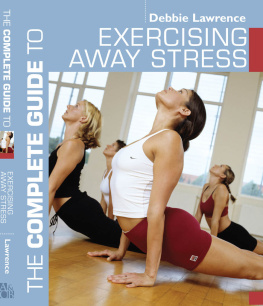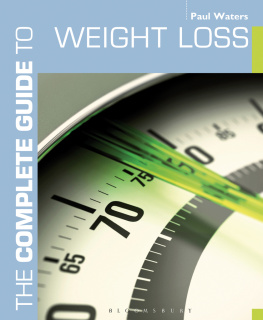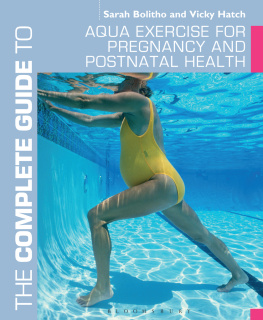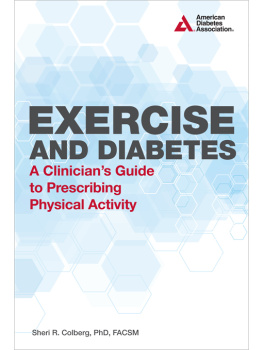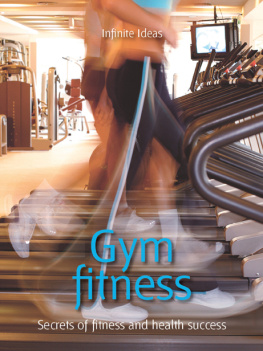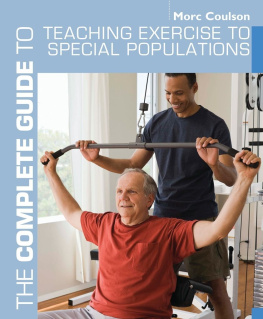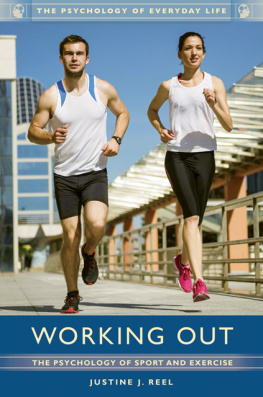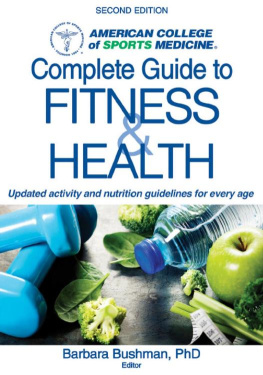
Contents
The aim of this book is to provide an introductory practical resource for exercise professionals who work or would like to work with clients referred to exercise by their GP or other health professional. It can be used as a resource by approved training providers and colleges, who are delivering the Level 3 Diploma in Exercise Referral (Qualification & Credit Framework QCF). The book raises awareness of some of the guidelines and considerations that should inform exercise professionals working with clients with specific medical conditions.
It does not replace the need for specialist training for those who work with the specific groups and special populations addressed in this book, nor does it replace the need to consult with a healthcare professional to support client work.
It is not the ultimate textbook or education reference for all medical conditions. A compendium of other resources has been researched and referenced to inform the contents. The book aims to introduce some medical conditions and discuss these at a level deemed by the writers to be a sufficient starting point for an exercise professional to develop his or her knowledge and experience. The book is a guide and a starting point for continued research and learning.
The strength of the book is that it makes recommendations and offers suggestions based on research and experience of working with these groups; it offers information on how to adapt exercise to enable participation by referred groups. The intention is to provide basic guidance, but in all instances the specific needs and requirements of the individual, together with any other relevant factors, should be considered and accounted for before making any exercise recommendation. In many instances, referred clients present with multiple rather than isolated conditions, and this may influence whether they are suitable for the scheme (risk stratification) and whether the Level 3 instructor is technically qualified and competent to work with them.
With this in mind, any exercise recommendation must be tailored to the individual with reference to all of his or her specific conditions and existing abilities and needs. Consultation with the clients GP regarding the frequency, intensity, time and type of exercise to be administered is also an essential factor in planning an individual schedule.
The book is planned in four parts:
: Explores the benefits of physical activity, barriers, risks and evidence base to support activity with current recommendations for minimum activity levels. It also provides an overview of the components of fitness and health.
: Explores the referral process and related information, which includes: risk stratification, roles and responsibilities, initial screening, assessments, and health and safety considerations.
: Focuses on medical conditions: signs and symptoms, prevalence, exercise limitations and guidelines and other interventions and lifestyle advice (medication and nutrition etc.). NB: Please always check the currency of medications with NICE and BNF guidelines. These often change and may vary both nationally and locally.
: Looks at how to create a helping relationship and how to help people make changes. There is a new chapter which offers some lesson plans to provide ideas for working with clients. These are not blueprints and will need to be adapted and revised to suit specific needs, but they do offer a starting point for planning. Some alternative activity approaches which may have benefits when working with referred clients are also introduced.
Happy reading!
The original guidance for the delivery of exercise referral was outlined in the National Quality Assurance Framework report (DoH, 2001), which defined the scope of practice for all persons involved in exercise referral. The report proposed a preliminary risk stratification tool (the risk stratification pyramid) and offered initial guidance for professional competence and medico-legal considerations. The report clearly stated as a boundary that it was not designed to provide a prescribed plan for how schemes should operate or be managed.
In 2006, the National Institute of Health and Clinical Excellence (NICE) commissioned a report to review the effectiveness of exercise referral as a mechanism for increasing activity. The report identified many inconsistencies of practice and procedures throughout the UK and a lack of evidence to support the effectiveness of referral schemes for increasing activity (NICE, 2006a). However, a lack of evidence did not mean that exercise or exercise referral was not effective as a means of preventing or managing disease.
In 2010, the British Heart Foundation National Centre for Physical Activity and Health developed the Exercise Referral Toolkit (BHF, 2010) which set out to evaluate the provision of exercise referral across the UK and from this, establish clearer guidance and standards for how schemes should operate, specifically with regard to:
protocols for operation
inclusion and exclusion criteria
risk stratification tools
team roles, responsibilities and boundaries (including specific guidance on referring to Registered Exercise Professionals)
monitoring and evaluation
In 2011, the Exercise Referral Advisory Group was established to review all previous guidance and the Joint Consultative Forum was formed. This saw, for the first time, the fitness sector and the royal medical colleges coming together to work toward facilitating the provision for advice to the medical and health professions, the fitness sector, healthcare commissioners and other relevant institutions and agencies on:
a) exercise in the promotion of health
b) exercise in the prevention of ill health
c) the use of exercise in the management of disease
The groups first project was to establish the Professional and Operational Standards in Exercise Referral Schemes. The updated guidance will acknowledge the many developments within exercise referral over the last decade and sets out to establish the way forward for the successful operation and management in the future.
Jean-Ann Marnoch, Registrar
Register of Exercise Professionals
2012
Exercise Referral Occupational Description
An exercise referral instructors role includes assessing pre-exercise readiness and designing, delivering, monitoring, adapting and tailoring exercise programmes for individual patients with one or more specific controlled medical condition. They collect and interpret relevant patient information aiming to ensure the safety and effectiveness of exercise programmes and actively encourage patients to adopt regular physical activity and an active lifestyle, employing appropriate motivational strategies to achieve this. (Full description available from REPs website)
The National Occupational Standards (NOS) for Exercise Referral (available from the SkillsActive website: www.skillsactive.com) underpin the structure and content of the new QCF Level 3 Diploma in Exercise Referral (2012) which comprises of six units:
1. Anatomy & physiology
2. Understanding the principles of nutrition
3. Professional practice for exercise referral instructors
4. Understanding medical conditions for exercise referral
5. Planning exercise programmes with patients
6. Instructing exercise referral with patients
The pre-requisite requirement for this qualification is a Level 2 Certificate in Fitness Instructing (ETM, Gym or Water Based Exercise).
Next page

